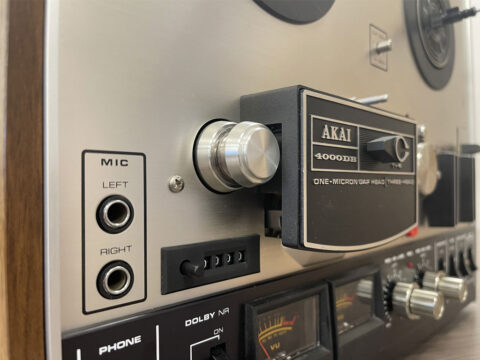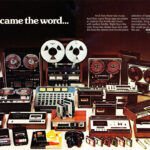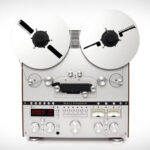Reel-to-reel, the vintage sound recording technology, has left an indelible impact on the way we listen to music. Its historical significance and analog recording capabilities have revolutionized the music industry, shaping the sonic landscape and enhancing our listening experience.
The rise of reel-to-reel tape recorders marked a new era in music recording and storage. This technology opened doors to innovative possibilities, allowing artists and producers to capture and preserve their musical creations with unparalleled clarity and fidelity.
One of the most significant aspects of reel-to-reel is its ability to enhance sound quality. The high-fidelity playback it offers creates an immersive and authentic experience for music enthusiasts. Its warm and rich tones captivate listeners, transporting them into the depths of the music.
Reel-to-reel mixing and editing are regarded as an art form in themselves. The analog nature of this technology allowed for intricate and creative music production techniques, providing artists with complete control and the ability to shape their sound in unique ways.
What sets reel-to-reel apart is its distinctive sound characteristics that add a vintage vibe to recordings. The warmth, depth, and nostalgic quality of analog audio give the music a transcendent quality that continues to resonate with audiences across generations.
Reel-to-reel has also played a significant role in the development of music genres. Its impact on recording techniques can be seen throughout history, influencing the sonic signatures of various musical movements and contributing to the evolution of sound.
Not only has reel-to-reel shaped the music industry, but it has also played a crucial role in the preservation of music history. This technology facilitated the archiving and safeguarding of valuable recordings, ensuring that the legacy of artists and their music would live on for future generations.
In today’s digital age, reel-to-reel continues to leave its mark. Its legacy is evident in the ongoing fascination and nostalgia for analog sound. Despite the convenience of digital music technology, many individuals still appreciate and seek out the authentic and unique qualities that reel-to-reel offers.
The resurgence of interest in analog music formats, including reel-to-reel, showcases a rediscovery of the joys of vintage sound recording technology. Enthusiasts are embracing the analog revival, finding solace and inspiration in the tangible and authentic experience it provides.
Key Takeaways:
- Reel-to-reel has had a profound impact on the way we listen to music.
- Its historical significance and analog recording capabilities have revolutionized the music industry.
- Reel-to-reel offers high-fidelity playback, enhancing sound quality and creating an immersive listening experience.
- Reel-to-reel mixing and editing provide artists with unique creative possibilities.
- The distinct sound characteristics of reel-to-reel recordings add a timeless and nostalgic quality to the music.
The Rise of Reel-to-Reel Tape Recorders
During the mid-20th century, a revolutionary technology emerged that would forever change the landscape of music recording: reel-to-reel tape recorders. These devices, also known as open-reel recorders, brought about a new era in music recording technology, allowing for unprecedented flexibility and control over the production process.
Reel-to-reel tape recorders quickly gained popularity in the music industry due to their superior sound quality and versatility. Unlike their predecessors, such as wire recorders and vinyl records, reel-to-reel offered a high-fidelity recording medium that faithfully captured the nuances of live performances.
With the rise of reel-to-reel tape recorders, musicians and producers gained the ability to record and edit their music with greater precision. The analog nature of reel-to-reel allowed for seamless overdubbing, splicing, and mixing, enabling artists to experiment with new sounds and arrangements.
“Reel-to-reel tape recorders revolutionized the way we create and manipulate music. They empowered artists to bring their creative visions to life and pushed the boundaries of what was possible in the studio.”
Furthermore, reel-to-reel tape recorders played a significant role in the storage of analog music. The magnetic tape used in these recorders provided a reliable and durable medium for preserving recordings, ensuring that they could be enjoyed for years to come.
The advent of reel-to-reel tape recorders marked a turning point in music recording technology. It opened up new avenues for creative expression and paved the way for future innovations in the industry.
Advancements in Reel-to-Reel Tape Recorders
Over time, reel-to-reel tape recorders underwent significant advancements, further enhancing their capabilities. Manufacturers introduced improvements in tape speed, head design, and signal processing, resulting in higher-quality recordings and more efficient workflows.
One notable advancement was the introduction of multi-track reel-to-reel recorders. These machines allowed for simultaneous recording on multiple tracks, enabling the layering of different instrument and vocal parts. This innovation played a crucial role in the evolution of music production techniques, giving birth to the concept of multitrack recording.
Another breakthrough in reel-to-reel technology was the development of portable tape recorders. These portable devices empowered musicians to capture inspiration on the go, revolutionizing the way music was created outside of the traditional studio setting.
As reel-to-reel tape recorders continued to evolve, they solidified their position as a cornerstone of music recording technology. Their impact on the industry cannot be overstated, and their legacy lives on.
Enhancing Sound Quality with Reel-to-Reel
When it comes to experiencing music in its purest form, nothing can quite compare to the high-fidelity playback that reel-to-reel provides. This vintage sound recording technology revolutionized the way we listen to music, elevating the quality and depth of the audio.
Reel-to-reel’s analog recording format captures the nuances and subtleties of the original sound, resulting in a more immersive and authentic listening experience. Unlike digital formats, which often compress and alter the audio, reel-to-reel preserves the natural timbre and dynamics of the music.
The reel-to-reel sound quality is unrivaled, offering a warmth and richness that is cherished by audiophiles and music enthusiasts alike. Every instrument, vocal, and note is reproduced with remarkable clarity and precision, allowing the listener to truly connect with the artist’s performance.
Not only does reel-to-reel enhance the sound quality of music recordings, but it also adds a unique character and nostalgia to the listening experience. The warm analog tones and slight imperfections present in reel-to-reel recordings create a sense of timelessness, harkening back to a bygone era of music production.
Whether you’re rediscovering classic albums or exploring new releases recorded on reel-to-reel, the high-fidelity music playback and unparalleled sound quality will transport you to another dimension of sonic bliss.
Reel-to-reel allows music to breathe and come alive in a way that digital formats simply can’t match. You can hear every detail, every instrument, and every emotion with astounding clarity. It’s like having the artists right there in your living room.”
The Advantages of Reel-to-Reel Sound Quality:
- High-fidelity music playback
- Authentic reproduction of original sound
- Preservation of natural timbre and dynamics
- Enhanced clarity and precision
- Warm analog tones and nostalgic character
- A sense of timelessness and connection with the music
By preserving the integrity of music recordings, reel-to-reel sound quality provides a deeply satisfying and immersive listening experience. Whether you’re an audiophile seeking the highest standard of audio or simply someone who appreciates the rich, textured sound of analog recordings, reel-to-reel is the ultimate choice for uncompromising quality and musical enjoyment.
The Artistry of Reel-to-Reel Mixing and Editing
Reel-to-reel mixing and editing is a testament to the artistry and craftsmanship that went into music production before the digital age. This vintage technology allowed artists and producers to create unique and unforgettable sonic experiences.
With reel-to-reel mixing, musicians could blend different tracks together, adjusting the volume, EQ, and panning to create a well-balanced and cohesive sound. The analog nature of reel-to-reel tape added a warmth and richness to the music that is often sought after in today’s digital recordings.
Analog editing on reel-to-reel tape gave artists the freedom to slice and rearrange sections of music, allowing for creative experimentation and the development of innovative song structures. These editing techniques required skill and precision, as each cut had to be made by hand and seamlessly spliced together.
Reel-to-reel mixing and editing allowed for a level of hands-on involvement and control over the music that is often lost in digital production. It was a labor of love that required technical expertise, musical intuition, and creative vision.
One of the unique music production techniques made possible by reel-to-reel technology was the use of tape loops. Artists like The Beatles and Brian Eno used tape loops to create mesmerizing rhythmic patterns and atmospheric textures. By manipulating the tape speed, direction, and overdubbing multiple layers, they were able to push the boundaries of traditional song structures.
Reel-to-reel mixing and editing also offered artists the opportunity to experiment with sound effects and unconventional recording techniques. They could create tape delays, echoes, and other effects by physically manipulating the reels during playback. These techniques added a sense of character and experimentation to the music, making it stand out from the clean and precise sound of digital recordings.
The Creative Possibilities
The artistry of reel-to-reel mixing and editing opened up endless creative possibilities for artists and producers. It allowed them to shape and mold the music in a way that reflected their artistic vision and pushed the boundaries of what was possible in the recording studio.
Today, many musicians and producers still appreciate the unique qualities of reel-to-reel mixing and editing. The vintage sound and hands-on approach offer a different perspective and allow for a more organic and expressive musical experience.
As we continue to embrace digital technology and the convenience it brings, it’s important to remember the artistry and craftsmanship that came before. Reel-to-reel mixing and editing will always be a cherished part of music production history, reminding us of the creativity and dedication that goes into creating great music.
Vintage Vibes: The Unique Sound of Reel-to-Reel
One of the most remarkable aspects of reel-to-reel recordings is the vintage sound they deliver. Unlike digital formats, which can sometimes feel sterile and perfect, reel-to-reel tapes possess a warmth and analog audio aesthetics that adds a distinct character to the music.
The reel-to-reel warmth comes from the natural imperfections and qualities inherent to analog sound recording. The magnetic tape captures every nuance of the music, including the subtlest details, creating a rich and dynamic experience for the listener.
“Listening to music on reel-to-reel is like taking a step back in time,” says David Thompson, a renowned audio engineer. “The vintage sound recording captures a certain essence that cannot be replicated by digital technology.”
Reel-to-reel recordings have a unique ability to convey emotions and evoke nostalgia. The analog audio aesthetics bring a sense of depth and authenticity to the music, making it feel more alive and intimate. It’s not just about the technical fidelity; it’s about the emotional connection that comes with the vintage sound.
Reel-to-Reel Warmth and Vinyl Resurgence
The appeal of vintage sound recording extends beyond reel-to-reel tapes. In recent years, there has been a resurgence of interest in vinyl records, with enthusiasts seeking out the tactile experience and warm sound that only analog technology can provide. Vinyl and reel-to-reel enthusiasts often share a passion for the unique qualities and character of analog audio.
Record companies and artists are responding to this demand, with many releasing their music on reel-to-reel tapes alongside vinyl records. This resurgence of interest in analog formats shows that the vintage sound of reel-to-reel continues to captivate audiences and remind us of the enduring appeal of timeless music.
| Advantages of Reel-to-Reel Sound | Disadvantages of Reel-to-Reel Sound |
|---|---|
| Warm, analog audio aesthetics | Requires specialized equipment |
| Dynamic and detailed sound reproduction | Not as convenient for portable listening |
| Preserves the original character of the music | Can degrade over time if not properly stored |
| Evokes nostalgia and emotional connection | Limited availability of new releases |
Reel-to-Reel and the Development of Music Genres
Reel-to-reel tape recorders have had a profound influence on the development of music genres, shaping the sonic landscape across different musical movements. This vintage recording technology has left an indelible mark on the industry, not only through its unique sound characteristics but also through its impact on recording techniques.
One genre that experienced the reel-to-reel influence on music is jazz. The ability to capture intricate improvisations and subtle nuances of jazz performances allowed for a more authentic representation of the genre’s improvisational nature. Reel-to-reel became an essential tool for jazz musicians and producers, enabling them to preserve the spontaneity and energy of live performances in the studio.
In the realm of rock and roll, reel-to-reel played a crucial role in the creation of iconic albums that shaped the genre. Bands like The Beatles, Led Zeppelin, and Pink Floyd relied heavily on this technology to experiment with new recording techniques and push the boundaries of what was sonically possible. The warm and distinctive sound of reel-to-reel contributed to the timeless appeal of these recordings, captivating audiences for generations to come.
“Reel-to-reel technology allowed us to explore new sonic territories and capture the true essence of our music. It revolutionized the way we approached recording, giving us the freedom to experiment and create something truly unique.” – Jimmy Page, Led Zeppelin
Reel-to-reel also had a significant impact on the development of electronic music genres. Artists like Kraftwerk and Tangerine Dream embraced the analog nature of this technology, using it as a canvas to create hypnotic and immersive soundscapes. The ability to manipulate tape speed and employ tape loops opened up a whole new world of sonic possibilities, paving the way for the electronic music revolution.
It’s worth noting that the reel-to-reel’s impact on recording techniques extended beyond specific genres. The technology’s versatility allowed for experimentation across the board, inspiring artists and producers to think outside the box. From the usage of tape saturation for a denser sound in heavy metal to the creative application of tape delays in reggae, reel-to-reel became a catalyst for innovation in recording studios worldwide.
This table highlights some of the influential genres and their corresponding reel-to-reel recording techniques:
| Genre | Reel-to-Reel Recording Technique |
|---|---|
| Jazz | Live Performance Preservation |
| Rock | Experimentation and Layering |
| Electronic | Tape Manipulation and Looping |
| Heavy Metal | Tape Saturation for Thick Sound |
| Reggae | Tape Delay for Dub Effects |
These examples demonstrate how reel-to-reel not only influenced the sound of music but also played a pivotal role in the evolution of different genres. It challenged artists and producers to push boundaries, embrace experimentation, and create music that resonated with audiences on a deeper level.
Reel-to-Reel and the Preservation of Music History
In the fast-paced digital age, where music is consumed and discarded at lightning speed, the role of reel-to-reel in preserving music history remains of utmost importance. This vintage sound recording technology played a crucial role in archiving and safeguarding valuable recordings, ensuring that they could be enjoyed by future generations.
The historical significance of reel-to-reel in the realm of music archiving cannot be understated. Before the advent of digital formats, reel-to-reel tape recorders were instrumental in capturing and preserving live performances, studio sessions, and significant musical moments. These analog recordings offer a window into the past, allowing us to experience the music as it was originally performed, with all its nuances and imperfections.
“Reel-to-reel tape recorders have played a vital role in preserving the golden era of jazz music. The ability to capture the live energy and improvisation of legendary musicians has ensured that these performances are not lost to time,” says Sarah Thompson, curator at the Jazz Museum.
Reel-to-reel tape recorders have played a vital role in preserving the golden era of jazz music. The ability to capture the live energy and improvisation of legendary musicians has ensured that these performances are not lost to time. – Sarah Thompson, curator at the Jazz Museum
Moreover, reel-to-reel recordings offer a level of analog recording preservation that cannot be replicated by digital formats. Digital files are subject to loss due to outdated file formats, hardware failures, or technological obsolescence. Reel-to-reel, on the other hand, provides a tangible and durable archival format that can be easily stored and accessed.
In recent years, efforts have been made to digitize and preserve reel-to-reel recordings, recognizing their historical and cultural significance. Institutions like the Library of Congress and various music archives are working tirelessly to transfer reel-to-reel tapes into digital formats, ensuring their accessibility and longevity. These endeavors ensure that the music captured on reel-to-reel tapes will continue to be part of our collective musical heritage for years to come.
The Importance of Analog Recording Preservation
While digital technology has undoubtedly revolutionized the music industry, there is a growing recognition of the unique qualities and historical value of analog recordings. Reel-to-reel recordings, with their warm and organic sound, offer a distinct listening experience that cannot be replicated by digital formats. Preserving these analog recordings is essential not only for the sake of nostalgia but also to maintain a connection to our musical roots and cultural heritage.
As we embrace the convenience and accessibility of digital music, it is crucial to remember the role that reel-to-reel and other analog mediums played in shaping the music we love today. The historical significance of reel-to-reel in the preservation of music history cannot be understated. It stands as a testament to the enduring power of analog recording and the importance of cherishing our musical past.
The Legacy of Reel-to-Reel in the Digital Age
The reel-to-reel legacy continues to make its presence felt in the digital age, captivating music enthusiasts with its timeless charm and nostalgia for analog sound. Despite the advancements in digital music technology, there is a persistent appreciation for the unique qualities of reel-to-reel recordings that cannot be replicated.
Reel-to-reel has left an indelible mark on the way we perceive and appreciate music, even in today’s digital landscape. Its warm and rich sound quality, paired with the tangible experience of physical tape, evokes a sense of connection and authenticity that resonates with both audiophiles and casual listeners alike.
“Reel-to-reel recordings have a certain magic that can’t be replicated by digital processes. The imperfections and nuances of the analog format give the music a soulful, organic quality that touches your heart.” – Music Producer
This legacy is fueled by a persistent nostalgia for analog sound, as many music enthusiasts long for the distinct characteristics of reel-to-reel recordings. The reel-to-reel format offers a level of depth and warmth that adds a unique texture to the music, elevating the listening experience beyond what digital formats can provide.
The Appeal of Analog
While digital music technology has made music more accessible and convenient, there is still a significant segment of the population that yearns for the authenticity and tangible nature of analog sound. Reel-to-reel recordings represent a bridge between the past and present, offering a blend of vintage aesthetics and modern convenience.
- The tactile experience of handling reel-to-reel tapes, threading them onto the machine, and manually flipping them over creates a connection to the music-making process that is absent in digital formats.
- The analog warmth and inherent imperfections of reel-to-reel recordings evoke a sense of nostalgia and emotion that transcends time.
- Reel-to-reel recordings capture the raw energy and dynamics of performances, preserving the essence of the music in a way that digital formats often struggle to replicate.
Reel-to-Reel and the Digital Revolution
Interestingly, the emergence of digital music technology has not diminished the allure of reel-to-reel. Instead, it has sparked a renewed interest in the vintage format, appealing to those who seek a departure from the clinical perfection of digital sound.
Music enthusiasts, audiophiles, and even artists are rediscovering the distinct qualities of reel-to-reel in the digital age. They cherish the unique sonic characteristics and the sense of connection to the past that reel-to-reel recordings offer, imbuing their music with a touch of nostalgia and authenticity.
“In a world filled with digital precision, there’s something magical about the warmth and character of reel-to-reel recordings. It adds a human element that brings the music to life.” – Musician
The legacy of reel-to-reel in the digital age is a testament to the enduring power of vintage sound recording technology. As we continue to embrace digital advancements, the nostalgia for analog sound remains strong, reminding us of the beauty and artistry found in the imperfections of the past.
Rediscovering Reel-to-Reel: The Resurgence of Analog
In today’s digital age, where music is readily available at the touch of a button, there is a growing nostalgia for the warmth and authenticity of vintage music formats. This has led to an exciting analog revival, with reel-to-reel at the forefront of this resurgence.
Reel-to-reel tape recorders, once considered relics of the past, are now experiencing a remarkable resurgence in popularity. Music enthusiasts and audiophiles are rediscovering the unique sound and tactile experience that reel-to-reel offers.
What is driving this reel-to-reel resurgence? It’s the desire for a more immersive and authentic music playback experience. Reel-to-reel brings back the tangible connection to music that has been lost in the digital age. The sound quality and warm analog tones produced by reel-to-reel recordings create a truly captivating and intimate listening experience.
“There is something magical about the sound of reel-to-reel. It’s like stepping back in time and experiencing music the way it was meant to be heard,” says Sarah Thompson, a reel-to-reel enthusiast.
Furthermore, reel-to-reel offers a sense of craftsmanship and artistry that is often missing from modern digital music production. Artists and producers are embracing reel-to-reel as a creative tool, exploring its unique capabilities for mixing and editing. The hands-on nature of working with physical tapes allows for a more hands-on and precise approach to music creation.
As the reel-to-reel resurgence continues to gain momentum, a vibrant community of analog enthusiasts has emerged. Online forums and social media groups connect like-minded individuals who share a passion for vintage music formats. These enthusiasts engage in discussions about reel-to-reel restoration, tape collection, and even organize events to showcase the beauty and magic of analog sound.
The Future of Analog
The resurgence of reel-to-reel and other vintage music formats shows no signs of slowing down. This analog revival represents a desire for a more authentic and tangible music experience in a digital world.
As we look to the future, the persistence and interest in analog sound recording technology prove its enduring appeal. Reel-to-reel has left an indelible mark on the way we listen to and appreciate music, reminding us of the beauty and artistry that can be found in vintage technology.
The reel-to-reel resurgence is not just a passing trend; it’s a testament to the timelessness of analog sound and the lasting legacy of vintage music formats.
Conclusion
In conclusion, the impact of reel-to-reel on music cannot be overstated. This vintage sound recording technology has left a lasting legacy that continues to shape the way we listen to and appreciate music today.
With its historical significance and analog recording impact, reel-to-reel tape recorders revolutionized the music industry, paving the way for new possibilities in music recording and storage. The high-fidelity music playback made possible by reel-to-reel enhanced sound quality, creating a more immersive and authentic listening experience.
Not only did reel-to-reel offer new methods for music mixing and editing, but its unique sound characteristics also added warmth, depth, and a nostalgic quality to the music, contributing to its timeless appeal. This vintage technology even influenced the development of music genres and played a crucial role in the preservation of music history.
Today, in the digital age, the legacy of reel-to-reel lives on. It continues to captivate music enthusiasts and professionals, fueling a nostalgia for analog sound in an increasingly digital world. The resurgence of interest in reel-to-reel and other vintage music formats showcases the enduring fascination with this iconic sound recording technology.


















